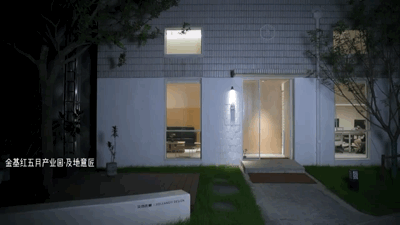查看完整案例

收藏

下载
The project is located in the northwest corner of Jinji Hongwu science and Technology Innovation Industrial Park, in Hongmiao 1st lane, Gulou District, Nanjing, adjacent to Jinchuan River and Nanjing University of Finance and economics. It is the former site of Jinling machinery factory. After the relocation of the factory in 19 years, the plot was transformed by Jinji group into a science and technology industry cluster in Gulou District.
项目位于金基·红五科技双创产业园的西北角,坐落于南京市鼓楼区洪庙一巷,毗邻金川河,紧靠南京财经大学,是金陵机械厂的旧址。19 年工厂搬迁后,该地块经过金基集团改造,成为鼓楼区的科技产业集聚区。
1980 年金陵机械厂航拍图
旧厂房与园区现状的对比
The project is located in the Jinchuanhe area, which contains historical memory and city fireworks. Jinchuan River is the place where the first ancestors of Nanjing people lived together. It is comparable to the Qinhuai River and has the reputation of "South Qinhuai, North Jinchuan". Jinchuan River is also a unique cultural business card of the Red May Science and Technology Double Innovation Industrial Park project. The renewal of historical industrial remains in the old city is also an important research direction of FANAF.
项目地处蕴含历史记忆以及市井烟火的金川河片区。
金川河为南京人始祖聚居之地,与秦淮河相媲美,有“南秦淮,北金川”之美誉。
金川河也是红五月科技双创产业园项目别具特色的文化名片。
老城区中历史工业遗存的更新,也是反几建筑的重要研究方向。
改造前建筑
The building was originally the power distribution room of the old plant, which was planned to be used as a single building after the transformation of the park. In view of the aging of ceramic tiles and the falling off of wall skins, the owner invited the project team to carry out the overall transformation design of the building.
该建筑原本是旧厂房的配电室,园区改造后作为独栋建筑规划使用。房屋年代久远,出现瓷砖老化,墙皮脱落,业主邀请反几对该建筑进行整体改造设计。
原建筑室内空间分割情况
The façade renovation strategy does not pursue “popularity”, it is more restrained, and basically retains the original building shape and color. The façade is divided into three different textures through different processes of German STO exterior wall paint.
外立面改造策略并不追求“流行”,较为克制,基本保留原有建筑形体和色调,将立面通过德国 STO 外墙涂料的不同工艺,分为三种不同质感。
改造后建筑立面
外立面改造后三种不同肌理
Human body size range: thin roll coating, retaining the texture of the tiles; six-meter high size range: thick spraying to maintain a sense of bulk; the rest of the area: polishing and cleaning, retaining the original tile color. It makes people feel no sense of distance, very kind, and perceives new vitality on the basis of perceiving the past history. The three textures also allude to the state of separation of indoor spaces.
人体尺度范围:薄型滚涂,保留瓷砖肌理;
六米层高尺度范围:厚型喷涂,维持体块感;
其余区域:打磨清理,保留原有瓷砖颜色。
让人没有距离感,很亲切,在感知曾经的历史基础上,察觉新的活力。
三种质感也同时暗喻室内空间分隔的状态。
二层加建位置与范围可以通过立面肌理和右侧玻璃透视中读出。
清理过的瓷砖与薄型滚涂墙面
The building was originally a brick-concrete structure. Due to the previous demand for power distribution equipment, the building was divided into a four-meter space and a six-meter space. The middle partition wall is a brick wall, which does not serve as the main structural function. In order to improve the overall space utilization, a structural reinforcement design was carried out, and partitions were added to open the partition wall between the two spaces and create new spatial connections.
建筑原为砖混结构,由于之前配电设备需求,建筑分为一个四米空间与一个六米空间。中间分隔墙体为砖砌墙,不做主要结构作用。
为提高整体空间利用率,反几进行结构加固设计,增设隔层,打开两空间之间的分隔墙体,创造新的空间联系。
剖面示意图
空间爆炸图
The layout continues the original building entrance relationship. Behind the entrance background wall is the equipment and service area, and the internal space is divided into the leisure reception area on the left and the office meeting area on the right. The original wall under the window was cancelled to expand the lighting surface and increase the interaction between indoor and outdoor.
平面布局上延续原建筑入口关系,入口背景墙后面为设备及服务区,并以此将内部空间分隔为左侧的休闲接待区域和右侧的办公会议区域。原本窗下墙取消,扩大采光面,增加室内外的互动。
入口左侧室外休闲区
The outdoor courtyard follows the edge shape of the road and the building, and forms an outdoor resting space with the high and low walls.
户外庭院顺延道路与建筑的边缘形状,与高矮墙形成户外休憩空间。
入口左侧接待会客区
接待会客区看向办公区
从二层阁楼看向一层与户外
The low entrance and reception area, and the slightly lower floor height give people a feeling of "want to sit down" and provide more comfort. Large-scale ceilings are set up in the lobby and meeting areas to hide the air conditioning and fresh air equipment; at the same time, the changes at the top also open up the rhythm with the office area.
低矮的入口及会客区,略低的层高给人一种“想坐下来”的感觉,提供更多的舒适感。前厅和会客区设置了大尺度的吊顶,隐藏了空调新风设备;同时,顶部的变化也拉开了与办公区之间的节奏。
接待会客区的天窗
家庭感的会客区
The floor height and layout of the reception area are closer to that of residential buildings, which makes the space feel like a family. The retreat of the suspended ceiling at the high window also increases the connectivity between the reception area and the outdoor courtyard, which is different from the traditional office impression.
会客区的层高和布局与住宅建筑更相近,这让空间变得带有家庭感。而吊顶在高窗处的退让,也增加了会客区与室外庭院之间的贯通性,这些都区别于传统的办公印象。
室内外的通透感
会客区的天窗
The right entrance is the office area, the whole is mainly functional, concise and clear.
The red horizontal structure and cylindrical vertical structure become the visual focus of the space.
入口右侧为办公区,整体以功能为主,简洁明了。红色的横向结构与圆柱竖向结构,成为空间的视觉焦点。
简洁明了的办公区
After the partition wall is cancelled, the original concrete beams are replaced by I-beams, and the concrete columns next to the opening are replaced by steel columns.
隔墙取消后,用工字钢梁替换原有凝土梁,用钢柱替换原有洞口旁混凝土柱。
横向与竖向结构
楼梯踏步与窗户关系
Let the structure become the visual focus of the office space. The partition part is separated from the wall, and the structure is stabilized by a single-sided structural column and a link boom.
让结构成为办公空间中的视觉中心。隔层部分则与墙体之间脱开,由单侧结构柱和链接吊杆保持结构稳定。
正面工字钢横梁与背部拉杆
Through the design, there is no rigid connection between the wall and the partition, forming a sense of suspension; the gap between the blocks is covered with solar panels to increase the penetration between the partition and the office area.
通过设计让墙体与隔层之间没有硬性连接,形成悬浮感;用阳光板覆盖体块间的空隙,增加了隔层与办公区之间的贯通性。
楼梯踏步与墙体及窗户的关系
In terms of material and detail processing, birch multi-layer boards are combined with white latex paint to create a minimalist atmosphere. By removing the wall tiles, applying latex paint and the smooth texture of the whole body, the contrast between the new and the old is formed, and the original structural beams and columns are exposed, retaining the texture of the historical brick wall.
在材质和细节处理方面,采用桦木多层板与白色乳胶漆结合,营造极简氛围。通过铲除墙砖涂刷乳胶漆与通体光滑肌理形成新与旧的对比,裸露原有结构梁柱,保留历史砖墙肌理感。
窗户桦木多层板与砖肌理墙面关系
办公区主要肌理
墙面局部肌理对比
In the process of urban renewal, a large number of residential areas are planned to be built around the remaining industrial parks. After the functional replacement of the industrial park, it is not a single office park, but includes various functions such as commerce, office, and leisure. This makes the park and the surrounding residents form a new and harmonious state of symbiosis.
在城市更新的过程中,保留下来的工业园区周围,规划建设大量的居住区。工业园区功能置换后,也非单一办公园区,包含商业、办公、休闲等各种功能。这使得园区与周围居民,形成一种全新的,和谐共生的状态。
散步绕弯的居民与工作室人员,和谐共生
平面图
剖面示意图
项目名称:及地匠意工作室改造设计
项目地址:南京市鼓楼区金基·红五月双创产业园
设计面积:74.8 平方米
设计公司:反几建筑 FANAF
项目负责:金鑫、王丽婕
设计团队:鲁越、钟少秋、王琪(实习)
设计范围:外立面改造、室内硬装、软装、灯光、vi、艺术品、景观设计
家具配合:上海 Van Collection 川至悦来家具有限公司、南京 MARATTI 家具
金属加工:南京广帆金属
景观配合:南京颐景景观工程设计有限公司
导视配合:及地匠意
施工团队:许详
设计周期:2021 年 4 月-2021 年 6 月
施工周期:2021 年 6 月-2021 年 7 月
撰文:金鑫、温昕、钟少秋
后期摄影:ingallery 金啸文、金鑫
特别鸣谢:金基集团各位领导对于项目的认可与配合;业主杨振宣先生给予方案的灵感与支持
Project title:Jidijiangyi studio renovation design
Project site:Jinji Hongwu science and Technology Innovation Industrial Park, in Hongmiao 1st lane, Gulou District, Nanjing
Interior area: 74.8㎡
Renovation: Fan Architectural Firm (FANAF)
Lead architect:Jin Xin,WangLijie
Design team:LuYue, Zhong Shaoqiu, Wang Qi(trainee)
Design scope: exterior facade renovation, interior hard decoration design, soft decoration design, lighting design, vi design, artwork design, landscape Design
Metal processing: Nanjing Guangfan Metal
Landscape coordination: Nanjing Yijing Landscape Engineering Design Co., Ltd.
Guidance and cooperation:Jidijiangyistudio
Construction team: Xu Xiang
Design cycle:2021.4-2021.6
Construction cycle:2021.6-2021.7
Author: Jin Xin,Wen Xin, Zhong Shaoqiu
Photography:ingallery
Jin Xiaowen, Jin Xin
Special thanks: Mr. Qiyue Wu and Ms. Yingni Shan of Jinji Group for their recognition and cooperation with the project;
Inspiration and support from the owner, Mr. Yang Zhenxuan
反几建筑
FANAF
反几事务所(FANAF)主要设计内容涵盖建筑、室内、景观、家具等,以旧建筑改造为主要设计方向,长期关注城市空间更新与乡村空间振兴活动。举一反几,创造更多可能性。
fanaf@fanaf.net
媒体联络
fanaf@fanaf.net
/ Sina weibo:
@反几建筑 反几建筑






















































